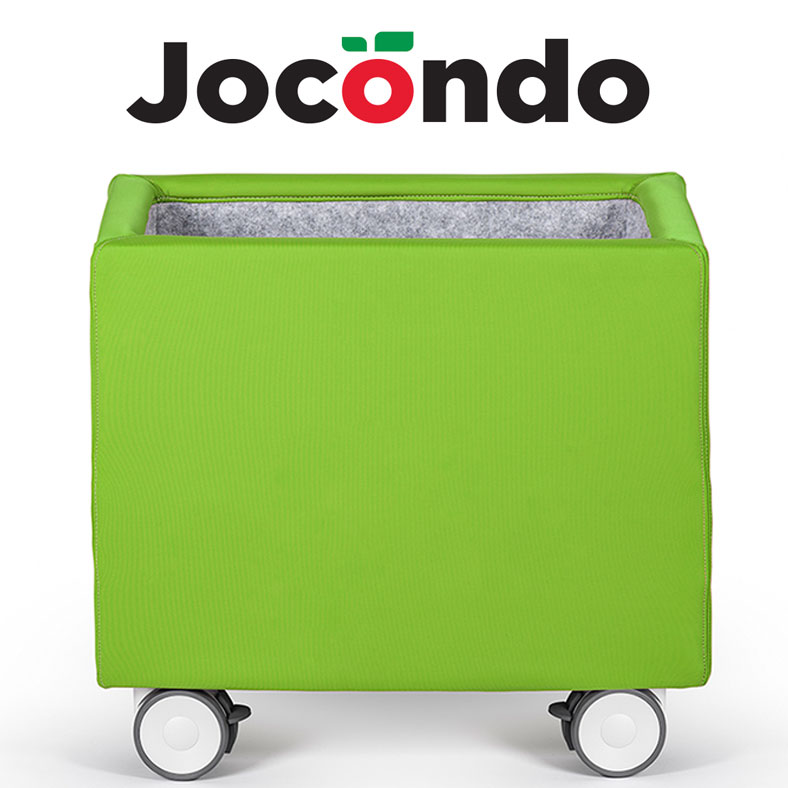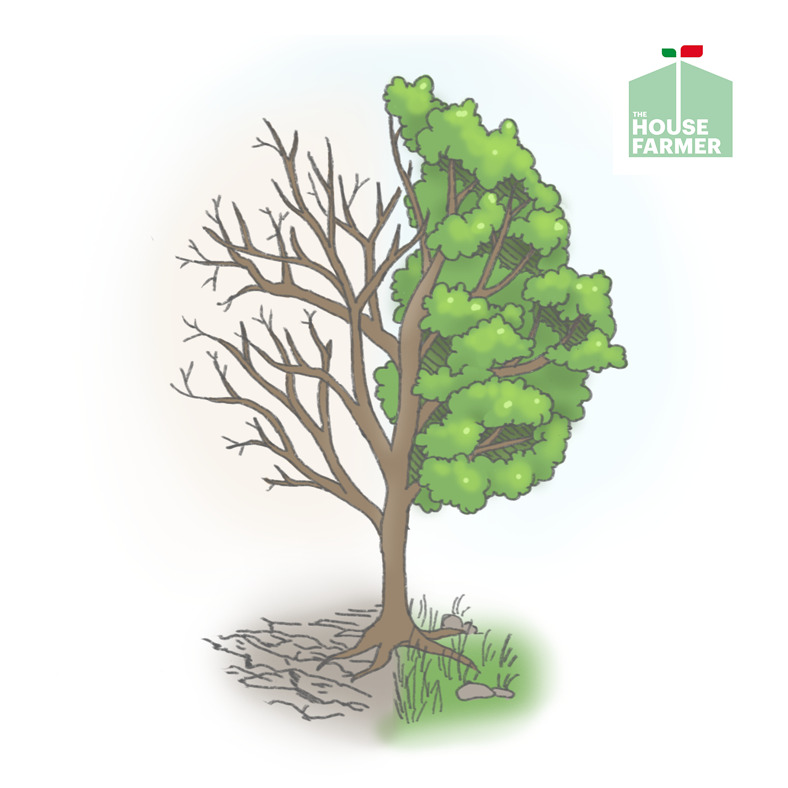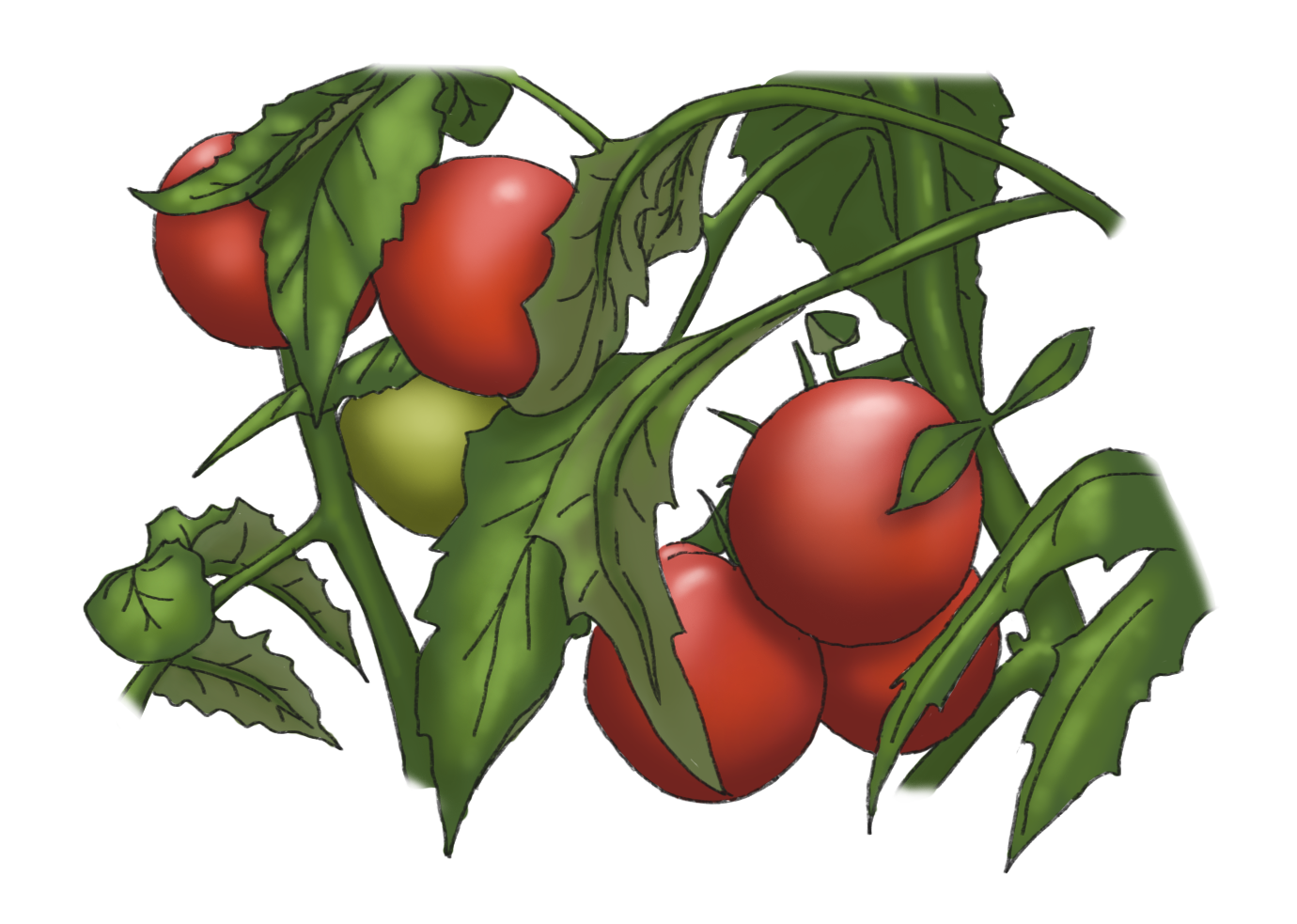
Growing Tomatoes Properly | All You Need to Know
In this post we will tell you about techniques for growing tomatoes and in particular we will talk about how to grow tomatoes from seeds and how to grow tomatoes in pots
But first let's start with a little bit of history.
HISTORY OF TOMATOES
The tomato is a plant native to Peru, cultivated in Mexico first by the Maya and then by the Aztecs. In the last 200 years it has become one of the most important vegetable crops; many varieties have been selected for cultivation, adapting the plant to the most diverse climates and soils.
It is a vegetable that cannot be missing from any good home vegetable garden, so here are some tips on how to grow tomatoes. As always, we consider growing our vegetables in accordance with organic cultivation, i.e. without using synthetic chemical insecticides but with natural methods of defence.
The aim is to obtain healthy and sustainable vegetables, we will see how to do this below.
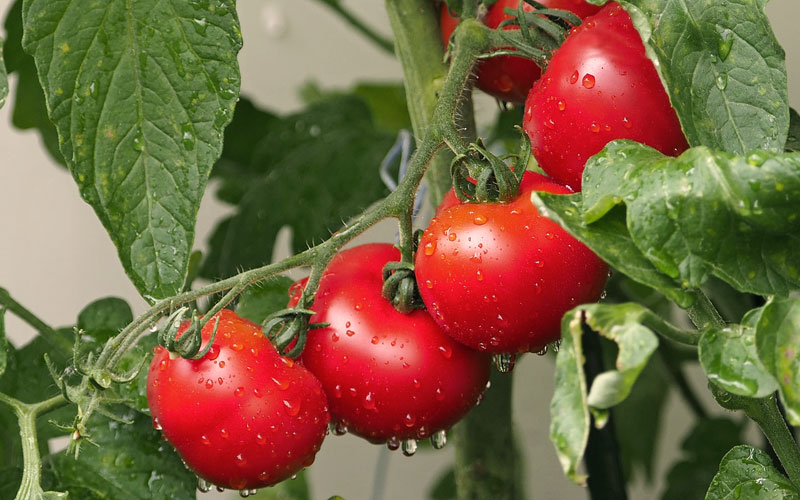
From the cherry tomato to the beefsteak tomato, from the classic sauce tomato to the extravagant black tomatoes, we are talking about a vegetable that never gets old, thanks to its many varieties and the thousands of uses it finds in the kitchen.
The satisfaction of eating a tomato picked directly from its own plant will repay all the agricultural work required, so let's see how best to grow this vegetable in an organic vegetable garden.
The right soil and climate for tomatoes
Best soil for tomatoes
The ideal soil for growing tomatoes is with ph=6, the soil must be fairly loose and draining, free of water stagnation which would favour plant diseases. To obtain a good harvest, the soil must also be rich in nutrients and organic matter. In fact, tomatoes are quite a 'greedy' vegetable.
Best climate for growing tomatoes
Although fairly cold-hardy types of tomatoes have been selected, they are still frost-hardy and, above all, require good sun exposure. You can grow tomatoes practically anywhere in Italy, provided you have a sun-kissed plot of land. The plant also fears excessive dryness, which can be limited by mulching and irrigation.
What fertiliser for growing tomatoes
Fertilisation of the tomato is very important for a good harvest, especially if the soil has been cultivated before. The most important contribution of organic matter is 'bottom fertilisation': this consists of putting fertiliser in the preparatory cultivation of the soil.
As a quantity we calculate 0.6 kg of organic pelleted fertiliser per square metre, 10 times as much if it is manure or mature compost.
If there is a choice, it is always better to use mature manure rather than pellets, as bringing in more substance amends the soil, improving its structure.
If production is staggered, fertiliser additions can be made during the course of the year, also intervening with water-soluble organic products such as oxblood or borlande (residues from beet processing).
When to sow tomato seeds
Sowing tomato plants
Tomatoes should be sown in a seedbed, between February and March; the seed germinates in about a week. It must be placed in a warm environment: it needs about 24 degrees to germinate. It then requires at least 13 degrees to grow. The tomato is a plant that is sensitive to temperature rather than light hours.
How far apart to plant tomatoes
In order to decide tomato plant spacing, it is necessary to know whether the plant is a determinate plant (it stops growing when it reaches a certain size, so requires no support) or an indeterminate plant (supports must be provided).
Garden tomatoes are usually of indeterminate growth and rows are made 70 cm apart (50 cm along the row between one plant and the next), it is convenient to arrange the supports (make two rows paired, the supports cross each other at the top, where they bind, in this way the support gains stability and one part never suffers root trauma.
Plants with a determinate habit are transplanted in rows 120 cm apart and 70 cm on the row, the distance is greater because they develop horizontally.
Planting the seedlings
The transplanting of tomatoes: from sowing in the seedbed to potting, up to the pre-flowering stage.
At this point one can transplant, provided that the minimum temperatures are at least 10 degrees.
The flowers need a minimum of 13 degrees in order to set, otherwise there is a fruitless droop. Transplanting in the pre-flowering phase, when the plants are about 30 cm high, allows the seedlings to be arranged with the flowers facing the outside of the flower bed, so all the flowers will emerge from that side and harvesting will be very comfortable.
Growing tomatoes
In order to successfully cultivate tomato plants in the vegetable garden, certain precautions must be taken:
- set up the right supports
- keep weeds at bay
- do not run out of water by watering as needed
- prune the plants correctly by cutting the tomato to the right height
Tomato plant support to tie up the growing tomatoes
In order to prevent the tomato plant from lying down as it grows, or worse, breaking under the weight of the fruit, it is very important to set up tomato plant supports.
The possibilities are manifold and if we go around different vegetable gardens we can discover many different do-it-yourself scaffolds.
For determinate-growing varieties a simple vertical stake driven into the ground is sufficient, but in many cases it is better to build more articulated structures.
The important thing is to ensure that the plant stands upright and gets plenty of sun. In addition to making the supports, one must remember to tie down the tomato stem as it grows, which is often overlooked.
Pruning tomato plants and sprouting
Pruning the axillary shoots
The tomato plant produces shoots at the axils of the various leaves, also called cacchi or femminella.
These should be cut off near the base as soon as possible (with the leaves or even with the nail), because they dissipate the plant's energy. The same applies to the suckers that grow at the base.
Females or suckers of a certain size can be used to reproduce the plant from cuttings, so that late tomatoes are obtained.
Cut axillaries can be left at the foot of the plants so as not to impoverish the soil. If the soil has too much nitrogen, females can also grow from the flower clusters and leaf veins.
Topping
The tomato should be left to grow until September, and then the central shoot is topped, allowing the plant to concentrate on the height it has achieved rather than elongating further. Determined growth varieties should not be topped.
How often to water tomatoes
When it comes to growing tomatoes properly, it is not easy to give correct indications on how often should you water tomato plants, certainly the tomato is a vegetable that has a fair water requirement.
For greenhouse cultivation the tomato needs 1,400 litres per square metre, in the vegetable garden of course it depends on the climate and the soil.
On average, 600 to 900 litres are sufficient, including those that fall as rain. To give you an idea, one millimetre of rain = 1 litre of water per square metre. If it does not rain normally, water once/twice a week, abundantly but without stagnating.
Growing Tomatoes: crop rotation
The tomato is a vegetable that is well fertilised and generally leaves a residual fertility that can be exploited by less demanding plants. After tomatoes, leguminous plants (such as broad beans, chickpeas, peas, beans) can also be cultivated optimally without background fertilisation, or liliaceae (garlic or onions).
Tomato plant problems
The tomato plant can fall prey to certain insects and, above all, is susceptible to various diseases and physiopathologies, which is why organic farming requires careful cultivation practices that can prevent problems, as well as constant monitoring that allows timely intervention.
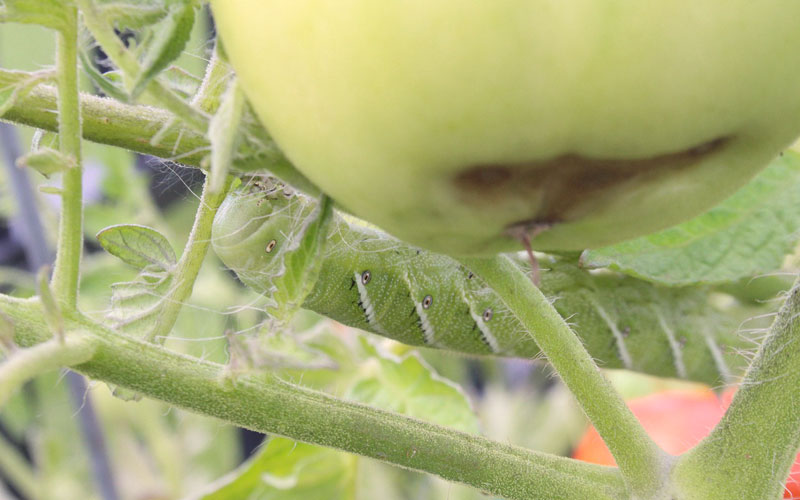
The main diseases that can affect a growing tomato
If fungal diseases occur, it is good to remember that the plants should be burnt or thrown in the rubbish and should not be used for composting or left on the ground.
In addition, spores of diseases such as tomato blight or fusarium can remain in the soil and affect the garden again the following years, which is why crop rotation is important.
In organic horticulture, prevention is crucial: if the conditions for a healthy vegetable garden are created, treatments can be avoided.
Downy mildew
This disease is recognisable by the yellowing of the leaves, looking against the light one can see different densities in the yellowed leaf. The colour then changes to brownish and spreads in patches on the stem and fruit. On tomato fruit, downy mildew manifests itself in patches in concentric circles. It normally strikes from mid-August onwards, due to night-time humidity and temperatures. Bordeaux mixture, copper oxychloride or otherwise organic copper-based products are used to combat it, although good prevention can reduce the use of fungicide.
Alternaria
Another fungal disease that affects tomatoes and, like downy mildew, starts with a yellowing of the leaves and then manifests itself in dark spots and rot in the fruit. Rot can be found in any part of the fruit, thus distinguishing it from apical rot, which is instead a physiopathy. Alternaria in organic farming is always combated with copper treatments.
Fusarium and Verticillium
Fusarium on tomatoes causes the plants to die quickly, withering away after withering. Opening the stem reveals black capillaries, a sign of the infection. The affected plant must be removed promptly, otherwise the disease will spread rapidly throughout our tomato crop.
Rhizottonia or pitium
A fungal disease that affects tomatoes, carrots and parsley, it acts when there is high humidity and temperatures of at least 20 degrees and affects the plant at the collar and roots. To avoid it, it is advisable to disinfect the sowing and vegetable garden soil with copper.
Bacteriosis
When tomatoes are affected by bacteriosis, small spots on the leaves and stunted growth occur; copper can cure this problem, as it is not irreversible like cryptogamic diseases.
Tomato physiopathologies
Unlike diseases, physiopathologies are problems caused by abnormal environmental conditions; restoring the correct situation can save the plant. Let us look at the main symptoms that something in the climate or soil is not going right.
Apical rot. It manifests itself as a black spot on the fruit, affects mainly stretched varieties and is jokingly called the 'black tomato butt'. Apical rot is generally due to a lack of water; it can also be due to too much nitrogen or potassium in the soil. It is one of the most common physiopathologies.
Boxing of the tomato. It happens that the fruit is soft and wilted because the development of the placenta stops. This phenomenon is called 'boxing' and is due to a sudden lack of water.
Non-colouration. With temperatures above 35 degrees, lycopene production stops, so the tomato does not take on colour. Often boxing of the fruit also occurs at the same time.
Flower dropout. The flowers dry up and fall off without producing fruit. It usually occurs for climatic reasons (too cold, too hot), but also happens due to states of plant distress or failure to pollinate the flowers.
Splitting of the fruit. The tomato thickens its skin in case of drought, subsequent heavy rains can split the fruit.
Cracking. They are caused by high air humidity and usually occur from the second half of August. They manifest themselves in the form of spider webs that only affect the upper part, while the lower part remains healthy.
Sunburn. The strong sun can turn the tomato fruit whitish or brownish; on days of strong summer sun, it is best to use shade nets to avoid this.
Cat's snout. These are three dry spots that appear on the fruit at the apex due to lack of auxin production. It occurs if too many leaves are removed from the plant, watch out for vigorous pruning.
Tomato insects and pests
From bugs to aphids, let's find out together who the garden enemies are that we can find on tomatoes and how to fight them without using toxic insecticides, but staying with organic methods.
Aphids. These tomato lice are dangerous above all because they transmit virosis to the plants; they can be recognised at first sight when they make the leaves curl up. In organic gardens, aphids can be combated with pyrethrum (organic insecticide) or natural methods such as garlic, nettle macerate or Marseille soap. The biological defence against aphids is mainly done by ladybirds, tireless predators of these little lice.
Elateridae. These are subterranean worms that attack the roots; their attack can be noticed by observing the unexplained decay of the plants.
Moths. The larvae of these moths emerge from the soil at night and eat the aerial part of the plants; they can be combated with bacillus thuringensis.
uta absoluta or tomato moth.
Dorifora. This beetle attacks solanaceous plants, although we find it most often on potatoes and aubergines.
Whitefly. Insect similar to aphids in its action.
Bugs. These insects spoil the fruit of tomatoes by stinging them, so it is advisable to take the necessary countermeasures, always within a biological and natural defence. To intervene with biological insecticides, it is useful to find the nest.
Slugs and snails. These gastropods eat the aerial part of the plant.
Mice and voles.
Tomato varieties to grow
The tomato is a vegetable for which many varieties have been selected, different may be the shape of the fruit (e.g. piriform, elongated, round, cherry-shaped) and the colour of the skin (from yellow to red, with streaks of black or green).
Above all we distinguish the different varieties of tomatoes according to the type of growth of the plant. We therefore have tomatoes with determinate growth (stops growing) or indeterminate growth (continues to grow and must therefore be topped).
Generally, determinate-growing plants are tomatoes destined for industry, while those for fresh consumption and therefore for the vegetable garden are indeterminate-growing, partly because they have scalar ripening and are therefore better for covering the consumption needs of the family garden, where the aim is to bring fresh vegetables to the table.
There are many famous tomato varieties, generally distinguishing sauce tomatoes from table tomatoes, from cherry tomatoes to cherry tomatoes. Good qualities of table tomatoes are for example marmande, cuore di bue and carmelo.
How to grow tomatoes from seeds
Preserving tomato seeds from one year to the next might be a good idea: it allows you to preserve a variety and avoid having to buy tomatoes every season. The important thing is to start with non-hybrid tomatoes.
Read more on tomatos if you are wondering how to grow tomatoes in pots and are looking for the best tomato planters.

